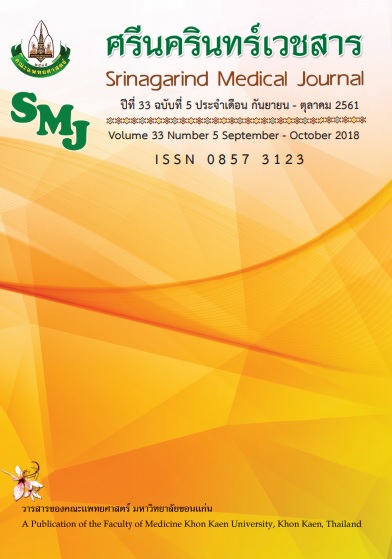Comparison of Bactericidal Efficacy between Ethanol- and Clorox®-containing Disinfectants in Laboratories
Keywords:
Ethanol; Clorox®; time-based manner; bactericidal activityAbstract
Background and Objective: Ethanol and Clorox® are chemicals used worldwide for disinfectant purposes in laboratories. However, there are some limitations of these chemicals; Ethanol is highly volatile, thus decreasing bactericidal activity, while Clorox® is corrosive and exposure to high concentration might cause severe irritation. In this study, we aim to determine the minimum concentration of Clorox® that still have bactericidal properties and to study the synergistic bactericidal properties of the mixture of Clorox® and Ethanol.
Methods: Five different conditions were used in this study; 2%Clorox®, 4%Clorox®, 2%Clorox® mixed with 70%Ethanol, 4%Clorox® mixed with 70%Ethanol, and 70%Ethanol. Bactericidal activities were evaluated against three bacteria species, S. aureus, E. coli and B. cereus, by Disc Diffusion Method. The onset and duration of sterilization were also observed in a time-based manner.
Results: The results revealed that bactericidal activities of all 5 conditions were significantly different when compared with negative control (p <0.05). The combination of 2%Clorox® mixed with 70%Ethanol and 4%Clorox® mixed with 70%Ethanol showed the best bactericidal activity. This study also found that all conditions, except 70%Ethanol, showed 100% bactericidal activity at 0 minute.
Conclusion: To ensure the high bactericidal efficacy, it is necessary to treat laboratory equipment for 10 minutes before cleaning. The mixture of 2%Clorox® and 70%Ethanol might be the best choice, considering the safety of using low concentration of Clorox® and prevention of bacterial resistance by using chemical combination.
References
2. เจษฎา นพวิญญูวงศ์, ชญานิศ ศรชัยธวัชวงศ์, จรรยา ศรีแสงจันทร์, สริน ทัดทอง และ อมรรัตน์ วิริยะโรจน์. ความคงตัวทางเคมีของแอลกอฮอล์ 70% หลังเปิดใช้. ศรีนครินทร์เวชสาร 2557; 29: 282-6.
3. กรมวิทยาศาสตร์การแพทย์. แนวทางการกำจัดขยะติดเชื้อไวรัสอีโบลา. สืบค้นเมื่อ 1 มีนาคม 2560 จาก http://nih.dmsc.moph.go.th/ebola/file/EbolaDMSc_04_1_Oct_2014.pdf
4. เมธินี ลักษมีการค้า, รุจิดา วิไลรัตน์, ธฤษิดา ปัญโญศักดิ์. ประสิทธิภาพของแอลกอฮอล์เจลและสารละลายแอลกอฮอล์ในการฆ่าเชื้อจุลชีพ. เวชสารแพทย์ทหารบก 2557; 67: 21-8.
5. Nweze EI, Mukherjee PK, Ghannoum MA. Agar – based disk diffusion assay for susceptibility testing of dermatophytes. Journol of Clinical Microbiology 2010; 48:3750-2.
6. Morton HE. Alcohols. In: Block SS, editor. Disinfection Sterilization and Preservation. 3rd ed. Philadelphia: Lea & Febiger, 1983: 225-39.
7. Moore SL, Payne DN. Types of antimicrobial agents. In: Fraise AP, Lambert PA, Maillard JY, editors. Principles and Practice of Disinfection Preservation and Sterilization. 4thed. Oxford: Blackwell Publishing, 2004: 8-97.
8. Rotter ML. Alcohols for Antisepsis of Hand and Skin. In: Ascenzi JM, editor, Handbook of Disinfectants and Antiseptics. New York: Marcel Dekker, 1996: 177-234.
9. ศันสนีย์ กระแจะจันทร์. การสำรวจความชุกโรคติดเชื้อในโรงพยาบาลมะการักษ์ พ.ศ. 2544. จุลสารชมรมควบคุมโรคติดเชื้อในโรงพยาบาลแห่งประเทศไทย 2544; 13: 2-11.
10. ศิริลักษณ์ ธีระภูธร, ฆนรส จ่างคำ, ปนัดดา เจิมศรี และ วันวิสาข์ ตรีบุพชาติสกุล. ประสิทธิภาพของน้ำยาฆ่าเชื้อแบคทีเรียและเชื้อราและการขจัดคราบเลือดบนเครื่องแก้ว. วารสารเทคนิคการแพทย์ 2555; 40: 4029-41.
11. ณัฐมน นิยมเดชา, ทิทยุต วงษาเนาว์, นริศรา มังกรแก้ว. เปรียบเทียบการออกฤทธิ์ของคลอเฮกซิดีนกลูโคเนตความเข้มข้น ร้อยละ 2 และร้อยละ 4 ในแอลกอฮอล์ต่อการทำลายเชื้อ สแตปฟิโลคอคคัส ออเรียส ที่ไวและดื้อต่อยาเมทิซิลินในห้องปฏิบัติการ. วารสารเทคนิคการแพทย์และกายภาพบำบัด 2559; 28: 220-6.
12. นงลักษณ์ สุวรรณพินิจ, ปรีชา สุวรรณพินิจ. ลักษณะและโครงสร้างละเอียดของแบคทีเรีย. จุลชีววิทยาทั่วไป. พิมพ์ครั้งที่ 2. กรุงเทพมหานคร: สำนักพิมพ์แหจุฬาลงกรณ์มหาวิทยาลัย, 2541: 42-73.




